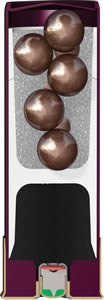- 01: Introduction
- 02: History
- 03: Propellants, Firearms, and Ammunition Development
- 04: Modern Firearms Manufacture
- 05: Small Arms Ammunition
- 06: Evidence Handling Procedures
- 07: Equipment and Instrumentation
- 08: Examination of Firearms
- 09: Cartridge and Shotshell Examination
- 10: Characterization and Evaluation of Fired Projectiles
- 11: Bullet Comparison and Identification
- 12: Gunshot Residue and Distance Determination
- 13: Toolmark Identification
- 14: Communicating Results
- Resources


Wadding
Home > Small Arms Ammunition > Shotshell Assembly > Loading > Wadding
Insertion
A wad (consistent with the type of projectile(s) to be loaded) is inserted. A tubular wad guide enters the case to prevent the soft plastic or fiber wad from snagging on the case mouth. Wads fed from above are oriented and aligned in a magazine. A punch enters the cup portion of the wad directly above the case, pushes it down onto the propellant charge, and applies light pressure. The punch is then withdrawn.

Buckshot wad
Inspection
The case moves on to an additional inspection station where a sensor rod is used to verify that a wad is present, aligned, and undamaged.
Projectile Loading
The vast majority of shotshells loaded are filled with small lead or nontoxic pellets, such as birdshot. Due to their small size, these pellets can be easily measured by volume. A guide tube is inserted into the case to protect the case mouth and to minimize spillage. The measured charge of shot flows from a storage hopper to the measuring device and on into the case.
Nontoxic shot, particularly steel, may require a special wad with heavier shot cup walls to protect the gun barrel. The loading machine has a different configuration of tool and die settings for lead and steel shot. Shotshells loaded with one-piece projectiles or large buckshot are loaded in much smaller quantities and can be assembled on less sophisticated equipment.
Shot Charge Verification
An inspection station immediately following the shot charging station ensures the proper amount of shot has entered the case.




